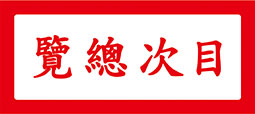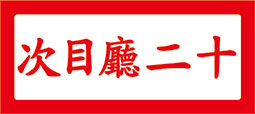
Front entrance of the former residence of Professor Ch’ien Mu in Taipei
Professor Ch’ien Mu, tzu Pin-ssu, was born in the 21st year of the Kuang-hsü reign (1895), he passed away in the 79th year of the Republic (1990), aged ninety six. This year is the 30th death anniversary of Professor Ch’ien, I wrote this special article in his memory.
Professor Ch’ien was profoundly learned, his writings were also extraordinarily extensive. In February, the 86th year of the Republic (1997), Linking Publishing of Taipei published Ch’ien Pin-ssu hsien-sheng ch’üan-chi (The Complete Works of Mr. Ch’ien Pin-ssu 錢賓四先生全集). Altogether there are fifty four volumes, and over twenty million words. They contain sixty nine books, the chapters are indeed voluminous, and extra addition is only superfluous. This is why the academic world is full of admiration, and readers of his works profess deep respect.
In my early years, I attained my doctorate degree at New Asia Institute of Advanced Chinese Studies. From 1993, I taught at the Graduate Institute of Asian Humanities, Huafan University in Taiwan, and retired there in 2009. Afterwards I returned to Hong Kong to teach until now at my alma mater. Due to the needs of my teaching, I have examined The Complete Works of Mr. Ch’ien Pin-ssu many times, and subsequently wrote two articles on the scholarship of Professor Ch’ien. They are: Tu Ch’ien Pin-ssu hsien-sheng “Po Hu Shih-chih shuo-ju” cha-chi (Reading Notes on “A Refutation of Hu Shih-chih’s Talk on Confucius” by Mr. Ch’ien Pin-ssu 讀錢賓四先生《駁胡適之說儒》札記), and Kung-t’an Ch’ien Pin-ssu chiao-shou “Lu-yü” chih yen-chiu yü chu-shu (A Deferential Discussion on the Studies and Writings of Professor Ch’ien Pin-ssu on the Analects 恭談錢賓四教授《論語》之研究與著述). The former was published in the 32nd volume of Hsin-ya hsüeh-pao (New Asia Journal 新亞學報), the latter was published in Hsiang-kang ching-hsüeh yen-chiu ti hui-ku yü ch’ien-chan kuo-chi hsüeh-shu yen-t’ao-hui lun-wen chi (香港經學研究的回顧與前瞻國際學術研討會論文集). Both articles were later compiled into Ho Kwong-yim lun-hsüeh tsa-chu hsü-pien (A Supplement to the Miscellaneous Writings on Chinese Studies by Ho Kwong-yim 何廣棪論學雜著續編).
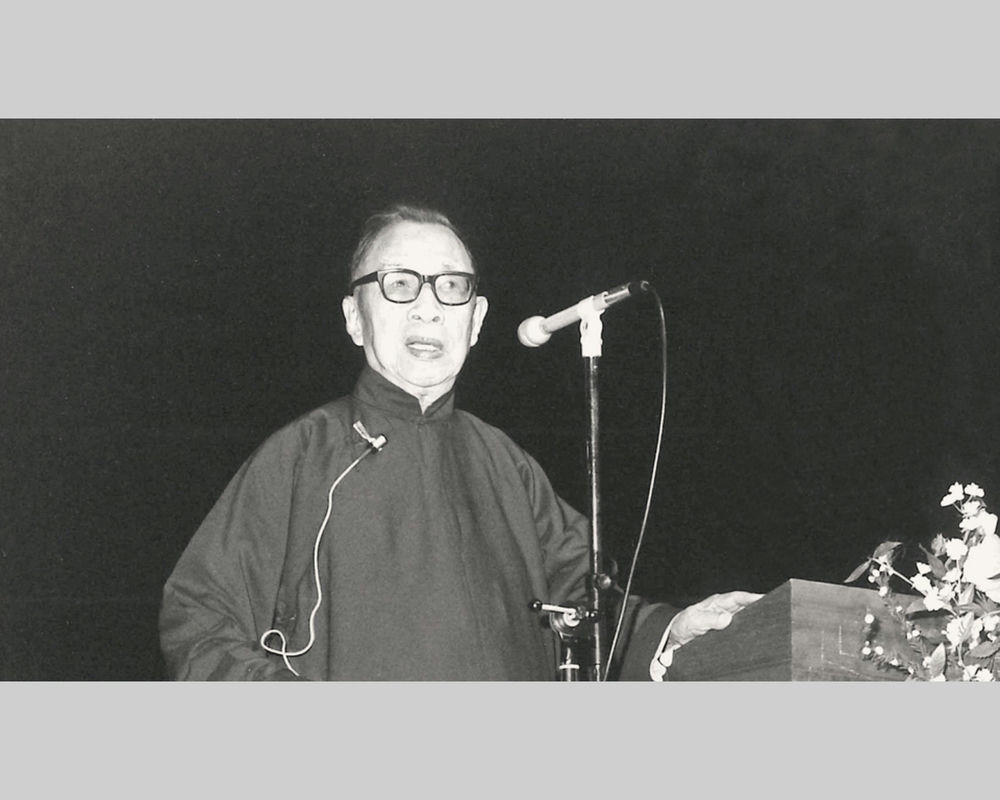
Professor Ch'ien Mu speaking at a lecture. Photograph courtesy Chinese University Hong Kong
This article will discuss five different facets of Professor Ch’ien’s life, his life story, his works, his founding of New Asia College, the publication of his complete works, and his missing work. From these I hope to expound for our readers his academic achievements and his contributions to education.
1. Life story
The academic achievements of Professor Ch’ien have been well extolled by academia. He taught at numerous well-known universities, including Yenching University and Peking University, he also received the distinction as an academician at the Research Center for Humanities and Social Sciences of Academia Sinica. After his death, numerous biographies and chronicles have been published, detailed accounts are thus already plentiful. Hence I hereby only quote the first paragraph of the Epilogue of Ch’ien Pin-ssi hsien-sheng ch’üan-chi (錢賓四先生全集編後語), for I enjoy its style of frugal words and concise expressions, which is enough to form an appreciation of the life story and interests of Professor Ch’ien.
The Epilogue of Ch’ien Pin-ssu hsien-sheng ch’üan-chi reads:
“Mr. Ch’ien Mu from Wu-hsi, tzu Pin-ssu, was born in the year of i-wei. the 21st year of the Kuang-hsü reign, Ch’ing dynasty. It was seventeen years before the founding of the Republic (1895). He passed away in the 79th year of the Republic (1990), at the age of ninety six. From the 1st year of the Republic onwards, Mr. Ch’ien became a teacher of a primary school in his hometown, then of a secondary school, then of a university, travelling across the land, spreading his knowledge in the south and the north, for a period of eighty years. He never stopped writing in his lifetime, and over fifty books were published before he passed away. To compare him with bygone and contemporary scholars, he was certainly exceptional. He dedicated his life to promulgate the fine traditional culture of China, he aspired to modify the dejecting trend of debasing historicism and idolizing Western culture, so that the self esteem and self confidence of the Chinese could be reinstated. It should be plainly recognizable that he was a pioneer who initiated the regeneration of the Chinese race. Certainly it will not be erroneous to laud him as a pre-eminent scholar.”
The lavish acclaim bestowed on Professor Ch’ien in the epilogue was not baseless exaltation.

Sculpture of Professor Ch’ien Mu in his former residence in Taipei, Taiwan
2. Works
The works of Professor Ch’ien are substantial and wide-ranging. To analyse the compiled material in Ch’ien Pin-ssu hsien-sheng ch’üan-chi 錢賓四先生全集, there are altogether sixty nine works. Most of them are classics by themselves, notable for their originality. To attempt a list of his representative works in the four separate sections of Ching (The Chinese Classics 經), Shih (History 史), tzu (Philosophy 子), Chi (Literature 集), my personal recommendations are as follows:
Ching Section (The Chinese Classics):
Lun-yü hsin-chieh (New Interpretation of the Analects 論語新解)
Liang-Han ching-hsüeh chin-ku wen p’ing-i (Commentary on the Classics Written in Ancient and Modern Scripts during the Han dynasty 兩漢經學今古文平議)
Shih Section (History):
Shih-chi ti-ming k’ao (A Study on Toponymy of the Records of the Grand Historian 史記地名考)
Chu-tzu hsin-hsüeh an (The Case of the New Scholarship of Chu-hsi 朱子新學案)
Chung-kuo chin san-pai nien hsüeh-shu shih (Three Hundred Years of Recent History of Chinese Scholarship 中國近三百年學術史)
Kuo-shih ta kang (Outlines of Chinese History 國史大綱)
Tzu Section (Philosophy):
Hsien-Ch’in chu-tzu hsi-nien (Chronological Study of the Pre-Ch’in Thinkers 先秦諸子繫年)
Chuang-tzu tsuan-chien (Compiled Annotations of Chuang-tzu 莊子纂箋)
Chi Section (Literature):
Hu-shang hsien-ssu lu (Record of Leisurely Thoughts by the Lake 湖上閒思錄)
Shuang-hsi tu-yü (Solitary Remarks at Shuang-hsi 雙溪獨語)
Pa-shih i shuang-ch’in (Remembering My Parents at Eighty 八十憶雙親)
Shih-yu tsa-i (Disorderly Reminiscences of Teachers and Friends 師友雜憶)

The exterior view of New Asia College on Kweiling Street, Kowloon, Hong Kong,1949. Photograph courtesy the Chinese University Hong Kong
3. The founding of New Asia College
Mr. Ch’ien was an admirer of Confucius throughout his life. He established New Asia College, imitating Confucius the sage by teaching students. In the 38th year of the Republic (1949), Professor Ch’ien saw China ablaze, the political situation worsened by the day, he had no alternative but to seek refuge in Hong Kong. Soon he connected with like minded scholars such as Chang P’i-chieh (張丕介), Wu Chün-sheng (吳俊升) and others, in succession founded New Asia College (新亞書院) and New Asia Institute of Advanced Chinese (新亞研究所) for higher education. Those who worked full time at the Institute were some of the most outstanding academics of the time, such as Yen Keng-wang (嚴耕望 1916-1996), Chüan Han-sheng (全漢昇 1912-2001), Hsü Fu-kuan (徐復觀 1904-1982), T’ang Chün-i (唐君毅 1909-1978), Mou Tsung-san (牟宗三 1909-1995), Mou Jun-sun (牟潤孫 1909-1988), P’an Chung-kuei (潘重規 1908-2003) and others. Those who worked part time were also distinguished educationalists, such as Lo Hsiang-lin (羅香林 1906-1978), Jao Tsung-i (饒宗頤 1917-2018), Li Huang (李璜 1895-1991), Wang Shao-sheng (王韶生 1904-1998) and others.
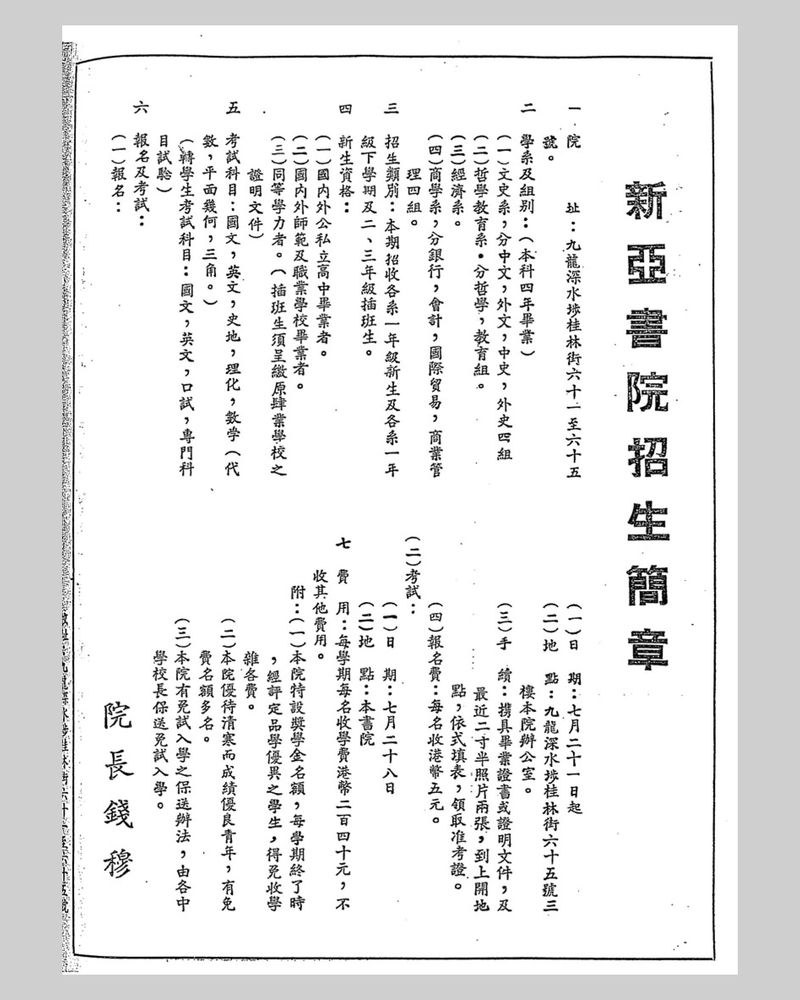
Promotional leaflet to enroll students for New Asia College in 1955. Photograph courtesy the Chinese University Hong Kong
It has been seventy years since the founding of New Asia College, countless outstanding students are educated there. An example is Yü Ying-shih (余英時), who is erudite and talented,his accomplishments have been exceptional, and he is an academician of Academia Sinica. Others include Sun Kuo-tung (孫國棟), Ho Yu-sen (何佑森), K’uang Chien-hsing (鄺健行),Ch’en Chih-ch’eng (陳志誠), Li Hsüeh-ming (李學銘), they have all worked in the field of education for decades with distinguished contributions. I attempted to closely observe the scholars from Hong Kong in the last hundred years, repeatedly comparing and examining their accomplishments, and came to the conclusion that Mr. Ch’ien, founder of New Asia College,was peerless. Professor Ch’ien could certainly be compared with Juan Yüan (阮元1764-1849), who was active in the Chien-lung and Chia-ch’ing reigns. Juan Yüan founded two schools, Ku-ching Ching-she (詁經精舍) and Hsüeh-hai T’ang (學海堂), both of which educated a great many talented students from Chekiang and Kwangtung provinces. Juan’s contribution to education seemed unrivalled in the whole of the Ch’ing dynasty.The unparallel eruditions of Juan and Ch’ien were long acknowledged by the academic world, as for their setting up educational institutions to safeguard talents for the country, to benefit society in their times, such contributions were indeed even more profound. From this perspective, the two of them were valiant giants in the cultural world, pillars of society, virtuous men who were hard to encounter even in the span of a thousand years.

The Complete Works of Mr. Ch’ien Pin-ssu, published by Linking Publishing. Photograph courtesy Kongfz website
4. Publication of the Complete Works
Linking Publishing undertook exhaustive effort and immense labour to publish Ch’ien Pin-ssu hsien-sheng ch’üan-chi. For the reader to appreciate the intricate story behind the publication, I will not be sparing with words by quoting word for word the related paragraph in the epilogue:
“After making the decision to appoint Linking Publishing as the publisher of the Complete Works, Mrs. Ch’ien invited a few students to form an editorial committee. The committee members were: Hsin I-yün (辛意雲), Ho Tse-heng (何澤恆), Shao Shih-kuang (邵世光), Chang Pei-pei (張蓓蓓), Tai Ching-hsien (戴景賢), Wang Jen-hsiang (王仁祥), Li Hsün-ch’in (李訓勤), Ch’en Jen-hua (陳仁華), Yen Hung-chung (閻鴻中), and Hsiao Kung-yen (蕭公彥). There were ten in the committee, the first five were also executive committee members, in charge of editorial work. Later on, a few more joined in to assist the work of editing, including the second son of Professor Ch’ien, Ch’ien Hsing (錢行), Wu Chan-liang (吳展良), Wang Ai-ling (王璦玲), Ho Kuang-ju (賀廣如), Chiang Min-hua (江敏華), Hung Su-nien (洪素年) and others. Delay happened during editing, and Mrs. Ch’ien, maiden name Hu Mei-ch’i (胡美琦女士), was invited to participate in editorial work. From September, the 80th year of the Republic (1991), assignments were divided up for allocation. First existing books were collected, then lost works were searched, to ascertain neither the weightier not the lighter works were overlooked, especially scrupulous to circumvent omission Within the next few years, Mrs. Ch’ien travelled to mainland China a number of times, and visited the libraries in the south and the north. Either by photocopy, or copy by hand, she collected many of the earlier published writings by Professor Ch’ien. In the National Central Library in Taipei, as well as other private and public libraries, collections of newspapers and magazines were examined, unperturbed by the labour of scrutinizing every page repeatedly. Some of the pages were completely unreadable, some of them had printing mistakes with suspiciously misplaced words. Relatives and friends in mainland China were asked many times to help out on their verifications, employing the postal service back and forth without interruption. That the Complete Works was able to incorporate many articles aside from the published books, was due to the dedicated effort of Mrs. Ch’ien.”
By reading the above quotation, we knew that the Complete Works was published through the collective effort of a large group of people, and amongst them, Mrs. Ch’ien was foremost in her endeavour.

Chih-chih Ts’ao-t’ang wen-kao by Li Jung-chieh. Photograph courtesy Canton Treasure Auction Co, Ltd
5. Missing work
The compilation of Ch’ien Pin-ssu hsien-sheng ch’üan-chi involved significant editorial work. The earlier quotation of the epilogue already affirmed:
“From September, the 80th year of the Republic (1991), assignments were divided up for allocations. First existing books were collected, then lost works were searched, to ascertain neither the weightier nor the lighter works were overlooked, especially scrupulous to circumvent omission.”
Although the editorial work entailed exhaustive effort, with large amount of material collected, to miss out on some precious gems, was still hard to avoid. According to my investigation, in the 42nd year of the Republic (1953), Professor Ch’ien was asked by Mr. Li Jung-chieh (李榕階) to write a preface for his book Lun-yü K’ung-men yen-hsing lu (Record of the Words and Deeds of Confucius’s Students in the Analects 論語孔門言行錄). This preface was not anthologized into the Complete Works, and remained a missing piece. Li’s book was published in the 43rd year of the Republic (1953), as part of a series Chih-chih Ts’ao-t’ang ts’ung-k’an pen (The Series of Publications from Chih-chih Ts’ao-t’ang 致知草堂叢刊本). It is now difficult to find even a single copy of this book. I borrowed a copy from Hong Kong Central Library, and the preface was located in the beginning of the volume. I copied the preface for the reader. It reads as follow :
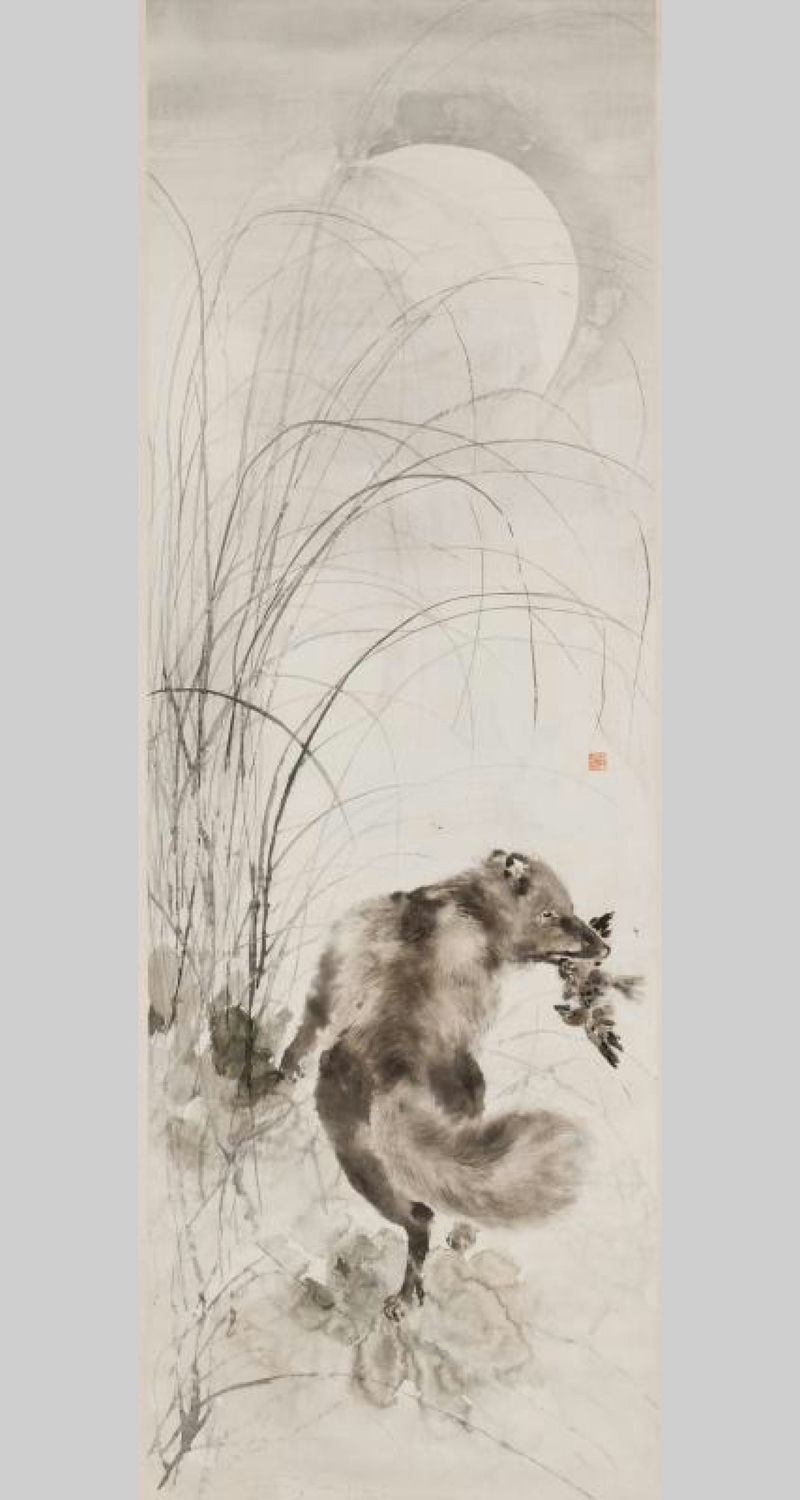
Ink hanging scroll of Dog in Evening Munching a Bird by Li Jung-chieh. Photograph courtesy Golden State Auction Gallery
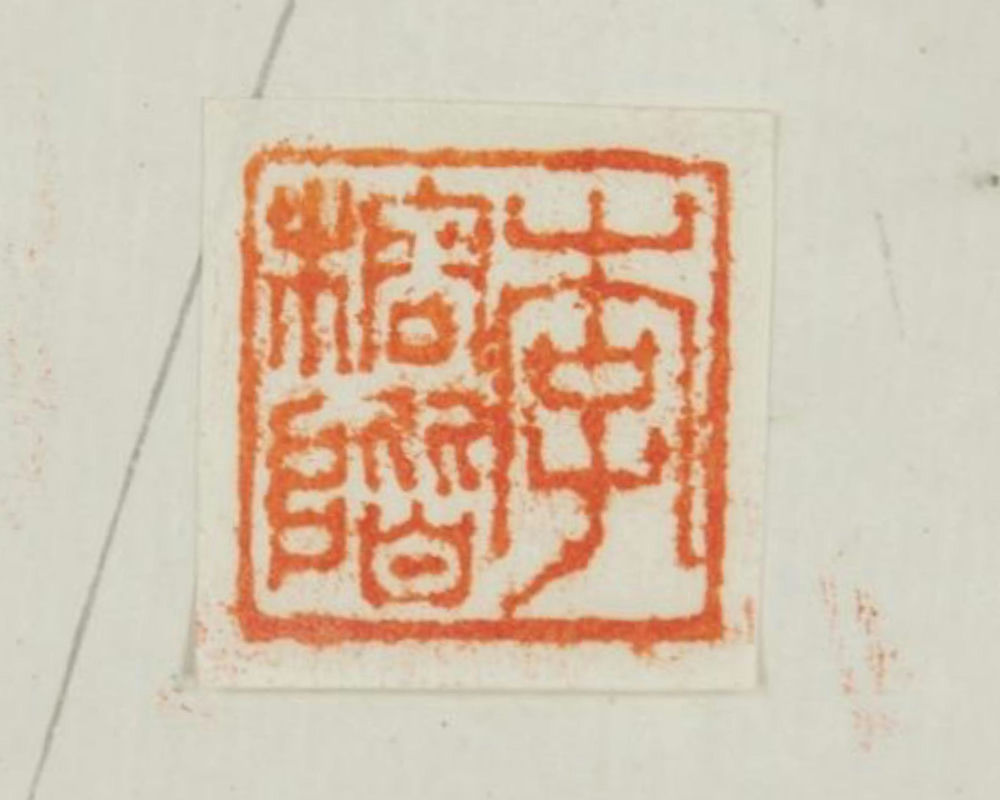
Seal impression on painting: “Li Jung-chieh”. Photograph courtesy Golden State Auction Gallery
Preface of Record of the Words and Deeds of Confucius’ Students in the Analects by Li Jung-chieh (李榕階)
I came to Hong Kong to seek refuge, and got to know Mr. Li Fen-fu (original name Jung-chieh 榕階, tzu Fen-fu 汾甫) from Hsin-hui. He showed me his work Record of the Words and Deeds of Confucius’s Students in the Analects, and said: ‘This book is about to be printed, please write a preface for me.’ I read the manuscript. It is a work that accumulated thirteen years of labour. An abundant amount of material has been acquired, references and conclusions have been meticulous, there are twenty six chapters, over two hundred and eighty thousand words. There has not been such a book since Ch’in (秦 221-206 BC) and Han (漢 202 BC-220 AD) dynasties. Scholars in the Han dynasty revered the Six Classics of Confucianism (六藝), while the Analects (論語), the Classic of Filial Piety (孝經) and Erh-ya (Chinese Lexicon 爾雅) were only listed in Hsiao-hsüeh (Elementary Learning 小學), they were not required by the officials of education. During the dynasties of Ts’ao Wei (魏 220-266 AD) and Liang Chin (晉 266-420 AD), men like Wang Pi (王弼) and Ho Yen (何晏) applied idle talk to discuss the Analects, sometimes they attained worthwhile conclusions, but mostly the spirit of the Classics was lost. In the Sung dynasty (960-1279 AD), Chi-chu (Annotations of the Four Books 集注) by Chu Hsi (朱熹 1130-1200) appeared, the expositions were detailed and considered, for six hundred years the book was regarded like decree, required reading by all Chinese in modern times. However, in Ssu-shu kai-ts’o (Correction to the Four Books 四書改錯) by Ch’ing scholar Mao Ch’i-ling (毛奇齡 1623-1716), he specifically labelled a chapter Pien-i sheng-men ts’o (To Censure the Mistakes of the Sage’s Students 貶抑聖門錯), his student Lu Pang-lieh (陸邦烈) also compiled Sheng-men shih-fei lu (Record of Elucidations of the Faults of the Sages’ Students 聖門釋非錄), and these defamations have not been rectified. Those who study the Analects since ancient times, have focused on Confucius, and overlooked the students, if we wish to investigate the details of Confucius teaching his students in those distant years, it is nothing but a regrettable situation. Ssu-ma Ch’ien (司馬遷 born in 145 BC) did write about the deeds of the students of Confucius in Chung-ni ti-tzu lieh-ch’uan (Biography of the Students of Confucius 仲尼弟子列傳), and in the book K’ung-tzu chia-yü (Family Sayings of Confucius 家語), there was a chapter titled Ti-tzu chieh (Explaining the Students 弟子解). However Family Sayings of Confucius had been tampered and modified by Wang Su (王肅 195-256 AD), and was no longer a truthful historic document. In Shih-chi chi-chieh (Collection of Annotations of the Records of the Grand Historian 史記集解) by P’ei Yin (裴駰), he quoted Cheng Hsüan (鄭玄 127-200 AD), and learned of the book K’ung-men ti-tzu mu-lu (Catalogue of the Students of Confucius 孔門弟子目錄), but it had already perished. Hsia Hung-chi (夏洪基) of the Ming dynasty (1368- 1644) wrote K’ung-men ti-tzu ch’uan-lüeh (Concise Biography of the Students of Confucius 孔門弟子傳略), Chu I-tsun (朱彝 1629-1709) of the Ch’ing dynasty (1644- 1912) wrote K’ung-men ti-tzu k’ao (A Study of the Students of Confucius 孔門弟子考), both books were too brief and inadequate. Today if we wish to examine the words and deeds of the students of Confucius in detail, it is all too difficult, because there is no such book. During the Ch’ing dynasty, when Juan Yüan (阮元 1764-1849) was governor-general of Kwangtung province, he established the school Hsüeh-hai T’ang (學海堂), and propagated the notion of simultaneously maintaining Han Confucianism and Sung Confucianism. Scholars from Kwangtung province such as Chu T’zu-ch’i (朱次琦 1807-1882), Ch’en Li (陳澧 1810-1882), K’ang Yu-wei (康有為 1858-1927), were all affected and rose to the occasion. Mr. Li Fen-fu inherited the academic tradition of Kwangtung province, by writing this book, he gathered the best of the past and the present, he established the true and the false, he expounded the essence and the minuscule, in each chapter, he synthesized Han Confucianism and Sung Confucianism, and he incorporated both evidential scholarship and argumentation. For those to follow, who are devoted to seek and explore the origins of the teachings of Confucius to his students, this is a book that cannot be ignored. To what realm this exacting and methodical book will carry the reader, it is to be discerned.
Ch’ien Mu respectfully wrote the preface in the year of kuei-i (癸已), the 42nd year of the Republic (1953), the two thousand five hundred and fourth birthday anniversary of Confucius, at New Asia College, Kowloon.”
No biography has been written on Mr. Li Jung-chieh, it is difficult to verify his life story. Reading the preface by Mr. Ch’ien, we knew his tzu was Fen-fu, and a native of Hsin-hui, Kwangtung province. He probably studied at Hsüeh-hai T’ang. If The Complete Works of Mr. Ch’ien Pin-ssu is to be reprinted in the future, I hope this preface can be included in the fifty third volume of the Complete Works, Su-shu Lou yü shen (素書樓餘瀋), as a piece of discovered work, and this is my wish.
Ho Kwong-yim, 2nd January, the 109th year of the Republic, at New Asia Institute of Advanced Chinese.

Artworks in the sitting room of Su-shu Lou
